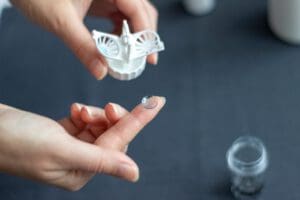How To Know If Keratoconus Is Progressing
Table of Contents
- Near Keratoconus
- Signs
- Timeline
- Treatment
Typically, your cornea is round and dome-shaped. In some people, it can thin out and get more than cone-shaped, which can be caused by the progressive disorder keratoconus. Blurry vision, sensitivity to light, swelling of the eye, and distorted vision can all be symptoms of keratoconus.
Keratoconus typically progresses slowly over several years. In the early on stages, keratoconus can be treated with soft contact lenses.
As it progresses, unlike forms of contacts can become necessary. Procedures similar corneal cross-linking can exist optimal for slowing the progression of keratoconus and improving vision and corneal stability.
What Is Keratoconus?

The cornea is the forepart part of your eye. A normal cornea is dome-shaped and round.
Keratoconus involves the thinning and irregular shaping of your cornea, which can cause it to become more cone-like. This ends upwards causing vision baloney, as calorie-free is no longer focused correctly onto the retina.
Keratoconus is likely to have a genetic component. The American Academy of Ophthalmology (AAO) reports that 10 percent of people struggling with the disorder have a parent who has it too. Eye allergies and excessive rubbing of the optics can too be risk factors for keratoconus.
Keratoconus typically begins in adolescence or early on machismo and progresses slowly over time, usually over a period of 10 to 20 years, the American Optometric Association (AOA) explains. In some cases, it tin progress apace and atomic number 82 to corneal swelling and scarring. Keratoconus tin can make it difficult to see clearly and ultimately requires vision correction.
Signs of Keratoconus
Early, signs of keratoconus include:
- Blurry vision
- Sensitivity to light
- Distorted vision, causing lines to look "wavy"
- Swelling of the heart
- Eye redness
As keratoconus progresses, yous may discover:
- Frequent changes in your eyeglass or contact lens prescription
- Cloudy vision
- Difficulties with night vision and driving at nighttime due to glares
- Problem plumbing equipment contacts in your optics
Keratoconus Timeline
Keratoconus can begin anywhere from age 10 to age 25, Mayo Dispensary publishes. It unremarkably progresses slowly for a catamenia of 10 years or so.
While keratoconus starts in late adolescence to early machismo, it continues to slowly progress upwards until about historic period twoscore or so. At this fourth dimension, the progression of the disorder usually stops.
Keratoconus can offset out with balmy vision distortion, merely information technology can and so progress into significant difficulty seeing conspicuously without correction. Typically, the disorder impacts both eyes, but keratoconus tin can progress differently in each eye.
Treatment Options

Options for treating keratoconus are going to depend on its severity and how speedily the disorder is progressing. In the early stages, eyeglasses or contact lenses tin be used to correct vision and the astigmatism of the cornea. As keratoconus progresses, boosted measures often need to exist explored.
Corneal cross-linking is a rubber and effective treatment option for keratoconus that has been shown to halt the progression of the disorder. It can besides serve to improve vision. For advanced keratoconus, surgical measures may exist necessary. Options include corneal implants.
- Soft contact lenses and/or eyeglasses: Early, eyeglasses or soft contact lenses tin help to right vision distortion and the astigmatism acquired by keratoconus. Soft contact lenses can be custom-fabricated specifically to treat keratoconus, and they are measured exactly to your optics and specifications. Typically, contact lenses designed to treat keratoconus are larger in diameter than traditional contact lenses, to give them more stability in the eye.
- Gas permeable contact lenses: Rigid gas permeable (RGP) contact lenses can "vault" over the cornea. They may and so provide a meliorate fit than soft contact lenses for keratoconus. Dissimilar eyeglasses or soft contact lenses, RGP contact lenses tin modify the shape of your heart, smoothing it out more, to improve your vision.It tin be tricky to fit contact lenses for keratoconus, however. Equally keratoconus progresses, your prescription can continue changing. It tin can fifty-fifty go to a point where it is uncomfortable to habiliment them in your eyes at all.
- Additional forms of contact lenses: There are other types of contact lenses that can be useful for treating keratoconus, such equally "piggybacking" two types of contact lenses, hybrid contact lenses, or scleral lenses.
- Piggybacking contacts : This involves using both a soft contact lens and a gas permeable lens — one on pinnacle of the other. The soft lens is placed in the eye first for comfort so the rigid lens is put on top of it to right shape. Your eye care provider will need to brand certain that enough oxygen can reach your eyes when using this method.
- Hybrid contact lenses : These contact lenses are a combination of soft and gas permeable lenses. They are rigid in the center to provide the vision and astigmatism correction of a gas permeable lens, with a comfortable outer ring that is a soft lens. Hybrid contact lenses fabricated specifically to treat keratoconus are often more comfortable than RGP lenses, offer better vision correction than soft lenses, and are less of a hassle than piggybacking.
- Scleral contact lenses : The white function of your middle is called the Scleral contact lenses are larger than typical contacts, covering a bigger diameter of the heart and resting on the sclera. They are still gas permeable lenses, but their size keeps them from moving around as much as traditional gas permeable lenses. They can vault over the cornea better without putting as much pressure on its irregular shape.
- Corneal cantankerous-linking: This is a procedure that was officially FDA-approved in 2016, but the journal Review of Optometry reports that it has been the chosen treatment for decision-making the progression of keratoconus since its inception in 2003. Corneal cross-linking is a minimally invasive, safe, and effective outpatient treatment for keratoconus that tin slow the progression of the disorder and improve vision.
Corneal cross-linking involves using liquid B2 (riboflavin) and controlled ultraviolet (UV) light to create links in the collagen fibers in your cornea. This both stabilizes and strengthens it.
This process can actually stop your cornea from thinning and condign more irregular. Other treatment methods just meliorate vision through corrective lenses while keratoconus continues to progress. Studies prove that corneal cantankerous-linking can improve vision, stop the progression of keratoconus, and flatten the irregular shape of the cornea. Results remain stable for at least a yr after the procedure.
Corneal cross-linking can also be combined with cosmetic eye surgery and corneal implants. A corneal cantankerous-linking procedure can reduce the need for corneal transplants too.
- Corneal implants: Implants, such as the thin prescription inserts Intacs, can exist inserted into the mid-cornea to flatten its irregular shape to correct for keratoconus. This is a surgical process that has been FDA-approved to treat keratoconus.
- The procedure is quick, taking x minutes or and so. The implants can be exchanged or removed equally needed through boosted procedures.
- Corneal implants, such as Intacs, can meliorate vision and be more than comfy than other contact lenses. However, they will not slow or stop the progression of the disorder like corneal cross-linking can.
- Corneal transplant: Avant-garde stages of keratoconus may require a corneal transplant. This is a surgical procedure. It is also chosen a penetrating keratoplasty or PKP.For this procedure, yous will need a donor with a good for you cornea. Most donor corneas are from deceased individuals.
Your irregular tissue will be removed and replaced. There is a take chances that your torso can pass up the transplant, Mayo Clinic. Even with a corneal transplant, you will oft still need to wear prescription eyeglasses or contact lenses to correct your vision. Y'all will not be able to vesture contacts until your corneas are completely healed, which can have upward to several weeks.
A corneal transplant is typically considered the concluding course of action in treating keratoconus. All other options take usually been explored and exhausted kickoff.
The data provided on this page should not be used in place of information provided past a dr. or specialist. To learn more than, read our Privacy Policy and Editorial Policy pages.
Source: https://www.nvisioncenters.com/keratoconus/#:~:text=As%20keratoconus%20progresses%2C%20you%20may,at%20night%20due%20to%20glares

0 Response to "How To Know If Keratoconus Is Progressing"
Post a Comment